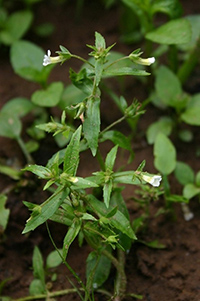Table of Contents
The hedge hyssop plant was widely used in the Middle and Modern Ages because it was supposed to have multiple medicinal virtues yet to be proven. It is still helpful as a substitute for the foxglove plant, though under medical control. Thus, its French name petite digitale.
- Expertly extracted from the certified organic leaf and flower of Hyssopus officinalis plants.
- Rapidly absorbed liquid extract.
- Gluten-free and non-GMO.
- Herb potency assured through High Performance Thin Layer Chromatography (HPTLC) analysis.

Healing Properties and Warning
The whole plant contains cardiotonic glycosides and has heart-stimulating, diuretic, and purgative properties.
It is used only in cases of intolerance to foxglove’s active components. Hedge hyssop has the advantage that, unlike foxglove, its cardiotonic glycosides do not accumulate in the body.
WARNING! We advise you to respect the indicated doses because it is a potentially toxic plant. Doses higher than those shown may provoke vomiting, intestinal colic, and bleeding. In massive intoxication, even heart failure can occur.

Hedge Hyssop Scientific Facts

- Other names: Gratiole.
- French: Petite digitale.
- Spanish: Graciola.
- Environment: Marshes and humid soils in Europe and North America.
- Description: This is a vigorous plant of the Scrofulariaceae family, growing from 15 to 30 cm high. It has a hollow stem, round at the base and quadrangular at the top. The leaves are finely toothed and oppositely disposed. The flowers are light pink or whitish. The plant has an unpleasant smell.
- Parts of the plant used medicinally: The dried plant in flower.
How to use Hedge Hyssop
- Infusion: With a maximum dose of two grams of ground dry plant per intake, up to a maximum daily amount of 10g.
- Fluid extract: The recommended dose is 20 drops, one to three times daily.
Frequently Asked Question
What are the proposed health benefits?
Traditional uses:
This plant has historically been used for liver problems, as a laxative, to increase urination, and for eliminating intestinal parasites. Potential (but unproven) benefits: Some limited studies suggest possible benefits for respiratory issues and viral infections.
Is there any scientific evidence supporting these benefits?
The evidence for hedge hyssop’s health benefits is minimal. Most studies are small-scale or conducted on animals. There is insufficient research to confirm its effectiveness in humans.
Can it help with coughs or sore throats?
While traditionally used for respiratory issues, there’s no solid scientific support. More reliable remedies exist for coughs and sore throats.
Does the plant have antiviral properties?
Laboratory studies hint at potential antiviral activity, but research on its effectiveness in humans is lacking. Do not rely on hedge hyssop to treat viral infections.
Are there antioxidant properties?
The plant contains antioxidants, but their specific effects and benefits within the human body require further investigation.
Is the plant safe to consume?
Hedge hyssop has serious safety concerns. It can cause seizures and other severe side effects. It should not be consumed without strict medical supervision.
Can it interact negatively with medications?
The plant could likely interact with various medications. If you’re taking any medication, it is crucial to avoid it.
Are there any specific preparations recommended for hedge hyssop?
Due to safety concerns, it’s strongly advised NOT to prepare or consume hedge hyssop at home.
Why is there so little research on the potential benefits of hedge hyssop?
The primary reason is the significant safety concerns associated with it. This makes large-scale human research difficult and ethically questionable.
I’m pregnant or breastfeeding. Is it safe for me to use hedge hyssop?
Absolutely not. It is highly unsafe for pregnant and breastfeeding women. It can pose severe risks to both the mother and the baby.
DISCLAIMER: All content on this website is presented solely for educational and informational objectives. Do not rely on the information provided as a replacement for advice, diagnosis, or treatment from a qualified medical expert. If you are pregnant, nursing, or have any preexisting medical concerns, talk to your doctor before using any herbal or natural medicines.
REFERENCES
- George D. Pamplona-Roger, M.D. “Encyclopedia of Medicinal Plants.” George D. Pamplona-Roger, M.D. Encyclopedia of Medicinal Plants. Ed. Francesc X. Gelabert. Vols. 1 San Fernando de Henares: Editorial Safeliz, 2000. 223. Print.
- WebMD – Hedge-Hyssop: https://www.webmd.com/vitamins/ai/ingredientmono-161/hedge-hyssop
- RxList – Hedge-hyssop https://www.rxlist.com/supplements/hedge-hyssop.htm
- Drugs.com – Hyssop https://www.drugs.com/npc/hyssop.html
- National Institutes of Health (NIH) – National Center for Complementary and Integrative Health (NCCIH) https://nccih.nih.gov/
- https://pubmed.ncbi.nlm.nih.gov/
Last update on 2024-07-22 / Affiliate links / Images from Amazon Product Advertising API

